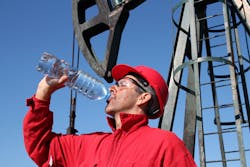Cal/OSHA Reminds Employers to Protect Workers from Heat Exposure
Cal/OSHA has issued an advisory to warn employers about protecting outdoor workers as temperatures are projected to reach highs in the triple digits.
The state-run agency's heat illness prevention standard is written for workers in all industries those in agriculture, construction, landscaping, security guards and groundskeepers, and transportation and delivery drivers who operate non-air conditioned vehicles.
"It is important for employers to assess the risk of heat illness based on a worker’s duties and take appropriate steps to prevent them from getting sick," Cal/OSHA stated. "Regardless of the level of risk, all outdoor workers must be protected equally and employers with outdoor workers must maintain an effective heat illness prevention plan year-round."
According to the regulation, employers must provide shade when temperatures reach 80 degrees or above, and workers should be encouraged to take rest breaks in the shade to prevent overheating.
Employers with outdoor workers also should the following steps to prevent heat illness:
- Plan – Develop and implement an effective written heat illness prevention plan that includes emergency response procedures.
- Training – Train all employees and supervisors on heat illness prevention.
- Water – Provide drinking water that is fresh, pure, suitably cool and free of charge so that each worker can drink at least 1 quart per hour, and encourage workers to do so.
- Shade – Provide shade when workers request it or when temperatures exceed 80 degrees. Encourage workers to take a cool-down rest in the shade for at least five minutes. They should not wait until they feel sick to cool down.
Workers who have existing health problems or medical conditions that reduce tolerance to heat, such as diabetes, need to be extra vigilant. Some high blood pressure and anti-inflammatory medications can also increase a worker’s risk for heat illness, Cal/OSHA representatives wrote in a statement.
To prevent heat illness, it is crucial that supervisors are effectively trained on emergency procedures in case a worker gets sick. This helps ensure sick employees receive treatment immediately and that the symptoms do not develop into a serious illness or death.
About the Author

Stefanie Valentic
Stefanie Valentic was formerly managing editor of EHS Today, and is currently editorial director of Waste360.
